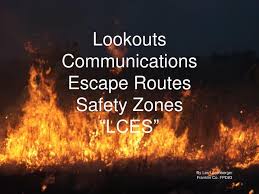"The afternoon of June 26, 1990, as I knelt beside a dead Perryville firefighter, I made a promise to the best of my ability to help end the needless fatalities, and alleviate the near misses, by focusing on training and operations pertinent to these goals."
Paul Gleason - Former Zig Zag Hotshot Superintendent
June, 1991
What is the role and responsibility of a Lookout in LCES?
- Have experience to recognize potential threats
- Be decisive
- Communicate clearly
- Be in a position to see potential threats and the entire crew
- Be in a safe location
As I explored the LCES concept and specifically Lookouts, I couldn't help but note the similarity to what we developed in our persistence awareness (PA) concept and use of Lookouts during real-world collaboration operations. In our PA concept, the Lookouts were responsible for unblinking environmental scan for mission-relevant change. John G., Research Scientist, Sandia National Laboratories developed the following graphic to depict the function of "Collaboration Lookouts" in maintaining PA for the enterprise.
 |
| Fort Model for Persistent Awareness Collaboratively Mastering Overwhelming Information "Keeping Up" John G., Sandia National Laboratories |
- Lookouts must scan the environment at a rate matching information change
- Lookouts must pay attention as many critical threat indicators are subtle and fleeting
- Return on attention will be reduced if Lookouts are hyper-focused on any narrow issue/part of the horizon
- To help analysis, Lookouts can not perform analysis
- Look for and notice the subtle vibrations related to unanticipated threats for personnel, equipment and structures
- Be decisive in alerting the crowd in chat rooms to what they were observing/hearing and dialog as part of the sense-making
- Communicate clearly using chat
- Access and pay attention to hundreds (if not thousands) of chat rooms looking for the unexpected
- Do all of the above from a safe location
Sound and look familiar? Bottom line - Collaboration lookouts are not distracted with building reports, making powerpoint charts, attending briefings or analyzing information.
To wrap-up, I continue to be encouraged with the similarities and opportunities of the collaboration concepts developed/executed in my previous career with what I am seeing in the emergency response world today. So, humor me a little as I think out loud...
Does the wildland fire community use an online collaborative Lookout in their chat tools in a similar way the Intelligence Community (IC) and Department of Defense (DoD) teams use Lookouts as part of their Human Net? If not, why not?
Thoughts?
Humbly,
Collabman

No comments:
Post a Comment